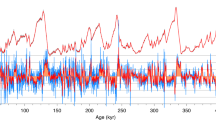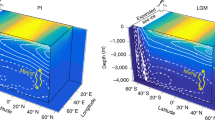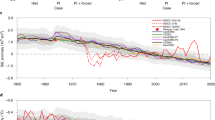Abstract
The climate of the last glacial period was extremely variable, characterized by abrupt warming events in the Northern Hemisphere, accompanied by slower temperature changes in Antarctica and variations of global sea level. It is generally accepted that this millennial-scale climate variability was caused by abrupt changes in the ocean thermohaline circulation. Here we use a coupled ocean–atmosphere–sea ice model to show that freshwater discharge into the North Atlantic Ocean, in addition to a reduction of the thermohaline circulation, has a direct effect on Southern Ocean temperature. The related anomalous oceanic southward heat transport arises from a zonal density gradient in the subtropical North Atlantic caused by a fast wave-adjustment process. We present an extended and quantitative bipolar seesaw concept that explains the timing and amplitude of Greenland and Antarctic temperature changes, the slow changes in Antarctic temperature and its similarity to sea level, as well as a possible time lag of sea level with respect to Antarctic temperature during Marine Isotope Stage 3.
This is a preview of subscription content, access via your institution
Access options
Subscribe to this journal
Receive 51 print issues and online access
$199.00 per year
only $3.90 per issue
Buy this article
- Purchase on Springer Link
- Instant access to full article PDF
Prices may be subject to local taxes which are calculated during checkout





Similar content being viewed by others
References
Voelker, A. H. L. & workshop participants. Global distribution of centennial-scale records for Marine Isotope Stage (MIS) 3: A database. Quat. Sci. Rev. 21, 1185–1212 (2002)
Dansgaard, W. et al. Evidence for general instability of past climate from a 250 kyr ice-core record. Nature 364, 218–220 (1993)
Schwander, J. et al. Age scale of the air in the summit ice: Implication for glacial-interglacial temperature change. J. Geophys. Res. 102, 19483–19494 (1997)
Lang, C., Leuenberger, M., Schwander, J. & Johnsen, S. 16°C rapid temperature variation in central Greenland 70,000 years ago. Science 286, 934–937 (1999)
Severinghaus, J. P. & Brook, E. J. Abrupt climate change at the end of the last glacial period inferred from trapped air in polar ice. Science 286, 930–934 (1999)
Heinrich, H. Origin and consequences of cyclic ice rafting in the northeast Atlantic Ocean during the past 130,000 years. Quat. Res. 29, 142–152 (1988)
Hemming, S. R. Heinrich events: Massive late Pleistocene detritus layers of the North Atlantic and their global climate imprint. Rev. Geophys. 42 (2004) doi:10.1029/2003RG000128
Blunier, T. & Brook, E. Timing of millennial-scale climate change in Antarctica and Greenland during the last glacial period. Science 291, 109–112 (2001)
Shackleton, N. J., Hall, M. A. & Vincent, E. Phase relationships between millennial scale events 64,000 to 24,000 years ago. Paleoceanography 15, 565–569 (2000)
Yokoyama, Y., Esat, T. M. & Lambeck, K. Coupled climate and sea-level changes deduced from Huon Peninsula coral terraces of the last ice age. Earth Planet. Sci. Lett. 193, 579–587 (2001)
Chappell, J. Sea level changes forced ice breakouts in the last glacial cycle: New results from coral terraces. Quat. Sci. Rev. 21, 1229–1240 (2002)
Siddall, M. et al. Sea-level fluctuation during the last glacial cycle. Nature 423, 853–858 (2003)
Clark, P. U., Webb, R. S. & Keigwin, L. D. (eds) Mechanisms of Global Climate Change at Millennial Time Scales 1–394 (AGU, Washington DC, 1999)
Stocker, T. F. & Marchal, O. Abrupt climate change in the computer: Is it real? Proc. Natl Acad. Sci. USA 97, 1362–1365 (2000)
Rahmstorf, S. Ocean circulation and climate during the past 120,000 years. Nature 419, 207–214 (2002)
Crowley, T. J. North Atlantic deep water cools the southern hemisphere. Paleoceanography 7, 489–497 (1992)
Stocker, T. F. The seesaw effect. Science 282, 61–62 (1998)
Broecker, W. S. Paleocean circulation during the last deglaciation: A bipolar seesaw? Paleoceanography 13, 119–121 (1998)
Ganopolski, A. & Rahmstorf, S. Rapid changes of glacial climate simulated in a coupled climate model. Nature 409, 153–158 (2001)
Stocker, T. F. & Johnsen, S. J. A minimum thermodynamic model for the bipolar seesaw. Paleoceanography 18, doi:10.1029/2003PA000920 (2003)
Stocker, T. F. & Wright, D. G. Rapid transitions of the ocean's deep circulation induced by changes in surface water fluxes. Nature 351, 729–732 (1991)
Mikolajewicz, U. & Maier-Reimer, E. Mixed boundary conditions in ocean general-circulation models and their influence on the stability of the models conveyor belt. J. Geophys. Res. 99, 22633–22644 (1994)
Rahmstorf, S. Rapid climate transitions in a coupled ocean–atmosphere model. Nature 372, 82–85 (1994)
Schmittner, A., Yoshimori, M. & Weaver, A. J. Instability of glacial climate in a model of the ocean-atmosphere-cryosphere system. Science 295, 1489–1493 (2002)
Jouzel, J. et al. Magnitude of isotope/temperature scaling for interpretation of central Antarctic ice cores. J. Geophys. Res. 108, doi:10.1029/2003JD002677 (2003)
Blunier, T., Schwander, J., Chappellaz, J., Parrenin, F. & Barnola, J.-M. What was the surface temperature in central Antarctica during the last glacial maximum? Earth Planet. Sci. Lett. 218, 379–388 (2004)
Stenni, B. et al. A late-glacial high-resolution site and source temperature record derived from the EPICA Dome C isotope records (East Antarctica). Earth Planet. Sci. Lett. 217, 183–195 (2003)
Johnsen, S. J., Dansgaard, W., Clausen, H. B. & Langway, C. C. Jr Oxygen isotope profiles through the Antarctic and Greenland ice sheets. Nature 235, 429–434 (1972)
Opsteegh, J. D., Haarsma, R. J.,, Selten, F. M. & Kattenberg, A. ECBILT: A dynamic alternative to mixed boundary conditions in ocean models. Tellus A 50, 348–367 (1998)
Goosse, H. & Fichefet, T. Importance of ice-ocean interactions for the global ocean circulation: A model study. J. Geophys. Res. 104, 23337–23355 (1999)
Stocker, T. F., Wright, D. G. & Broecker, W. S. The influence of high-latitude surface forcing on the global thermohaline circulation. Paleoceanography 7, 529–541 (1992)
Schiller, A., Mikolajewicz, U. & Voss, R. The stability of the thermohaline circulation in a coupled ocean-atmosphere general circulation model. Clim. Dyn. 13, 325–348 (1997)
Manabe, S. & Stouffer, R. J. Coupled ocean-atmosphere model response to freshwater input: Comparison to Younger Dryas event. Paleoceanography 12, 321–336 (1997)
Huang, R. X., Cane, M. A., Naik, N. & Goodman, P. Global adjustment of the thermocline in response to deepwater formation. Geophys. Res. Lett. 27, 759–762 (2000)
Hsieh, W., Davey, M. K. & Wajsiwicz, C. The free Kelvin wave in finite-difference models. J. Phys. Oceanogr. 13, 1383–1397 (1983)
Johnson, H. & Marshall, D. P. A theory for the surface Atlantic response to thermohaline variability. J. Phys. Oceanogr. 32, 1121–1132 (2002)
Allen, J. R. M. et al. Rapid environmental changes in southern Europe during the last glacial period. Nature 400, 740–743 (1999)
Wang, Y. J. et al. A high-resolution absolute-dated late Pleistocene monsoon record from Hulu Cave, China. Science 294, 2345–2348 (2001)
Burns, S. J., Fleitmann, D., Matter, A., Kramers, J. & Al-Subbary, A. A. Indian ocean climate and an absolute chronology over Dansgaard/Oeschger events 9 to 13. Science 301, 1365–1367 (2003)
Peterson, L. C., Haug, G. H., Hughen, K. A. & Röhl, U. Rapid changes in the hydrologic cycle of the tropical Atlantic during the last glacial. Science 290, 1947–1951 (2000)
Steig, E. J. et al. Synchronous climate changes in Antarctica and the North Atlantic. Science 282, 92–95 (1998)
Mulvaney, R. et al. The transition from the last glacial period in inland and near-coastal Antatctica. Geophys. Res. Lett. 27, 2673–2676 (2000)
Kanfoush, S. L. et al. Millennial-scale instability of the Antarctic Ice Sheet during the last glaciation. Science 288, 1815–1818 (2000)
Weaver, A. J., Saenko, O. A., Clark, P. U. & Mitrovica, J. X. Meltwater pulse 1A from Antarctica as a trigger of the Bølling-Allerød warm interval. Science 299, 1709–1713 (2003)
Wunsch, C. Greenland-Antarctic phase relations and millennial time-scale climate fluctuations in the Greenland ice-cores. Quat. Sci. Rev. 22, 1631–1646 (2003)
Roe, G. H. & Steig, E. J. Characterization of millennial-scale climate variability. J. Clim. 17, 1929–1944 (2004)
Broecker, W. S. Thermohaline circulation, the Achilles heel of our climate system: Will man-made CO2 upset the current balance? Science 278, 1582–1588 (1997)
Timmermann, A., Justino, F. B. & Jin, F.-F. Surface temperature control in the north and tropical Pacific during the last glacial maximum. Clim. Dyn. (in the press)
IPCC. Climate Change: The Scientific Basis. Contribution of Working Group I to the Third Assessment Report of the Intergovernmental Panel on Climate Change (Cambridge Univ. Press, Cambridge/New York, 2001)
Enting, I. G. On the use of smoothing splines to filter CO2 data. J. Geophys. Res. 92, 10977–10984 (1987)
Acknowledgements
We are grateful to the model developers and KNMI for making ECBILT-CLIO available to the scientific community, to F. Justino and U. Krebs for setting-up the glacial version of the model, and to N. Shackleton for discussions. This work was supported by the Swiss National Science Foundation, the Swiss Federal Office of Science and Education through the EC project POP and the University of Bern. A.T. was supported by the Deutsche Forschungsgemeinschaft through a Collaborative Research Project.
Author information
Authors and Affiliations
Corresponding author
Ethics declarations
Competing interests
The authors declare that they have no competing financial interests.
Supplementary information
Supplementary Figure 1
Sensitivity of the CGAOM to glacial boundary conditions. (PDF 90 kb)
Supplementary Figure 1 Legend
Sensitivity of the CGAOM to glacial boundary conditions. (DOC 24 kb)
Rights and permissions
About this article
Cite this article
Knutti, R., Flückiger, J., Stocker, T. et al. Strong hemispheric coupling of glacial climate through freshwater discharge and ocean circulation. Nature 430, 851–856 (2004). https://doi.org/10.1038/nature02786
Received:
Accepted:
Issue Date:
DOI: https://doi.org/10.1038/nature02786
This article is cited by
-
The weakening AMOC under extreme climate change
Climate Dynamics (2024)
-
Effect of orographic gravity wave drag on Northern Hemisphere climate in transient simulations of the last deglaciation
Climate Dynamics (2022)
-
Datasets for the CMIP6 Scenario Model Intercomparison Project (ScenarioMIP) Simulations with the Coupled Model CAS FGOALS-f3-L
Advances in Atmospheric Sciences (2021)
-
Asynchrony between Antarctic temperature and CO2 associated with obliquity over the past 720,000 years
Nature Communications (2018)
-
Sedimentary Characteristics of the Second Marine Layer During the Late Marine Isotope Stage 3 in Southern Yellow Sea and Their Response to the East Asian Monsoon
Journal of Ocean University of China (2018)
Comments
By submitting a comment you agree to abide by our Terms and Community Guidelines. If you find something abusive or that does not comply with our terms or guidelines please flag it as inappropriate.



